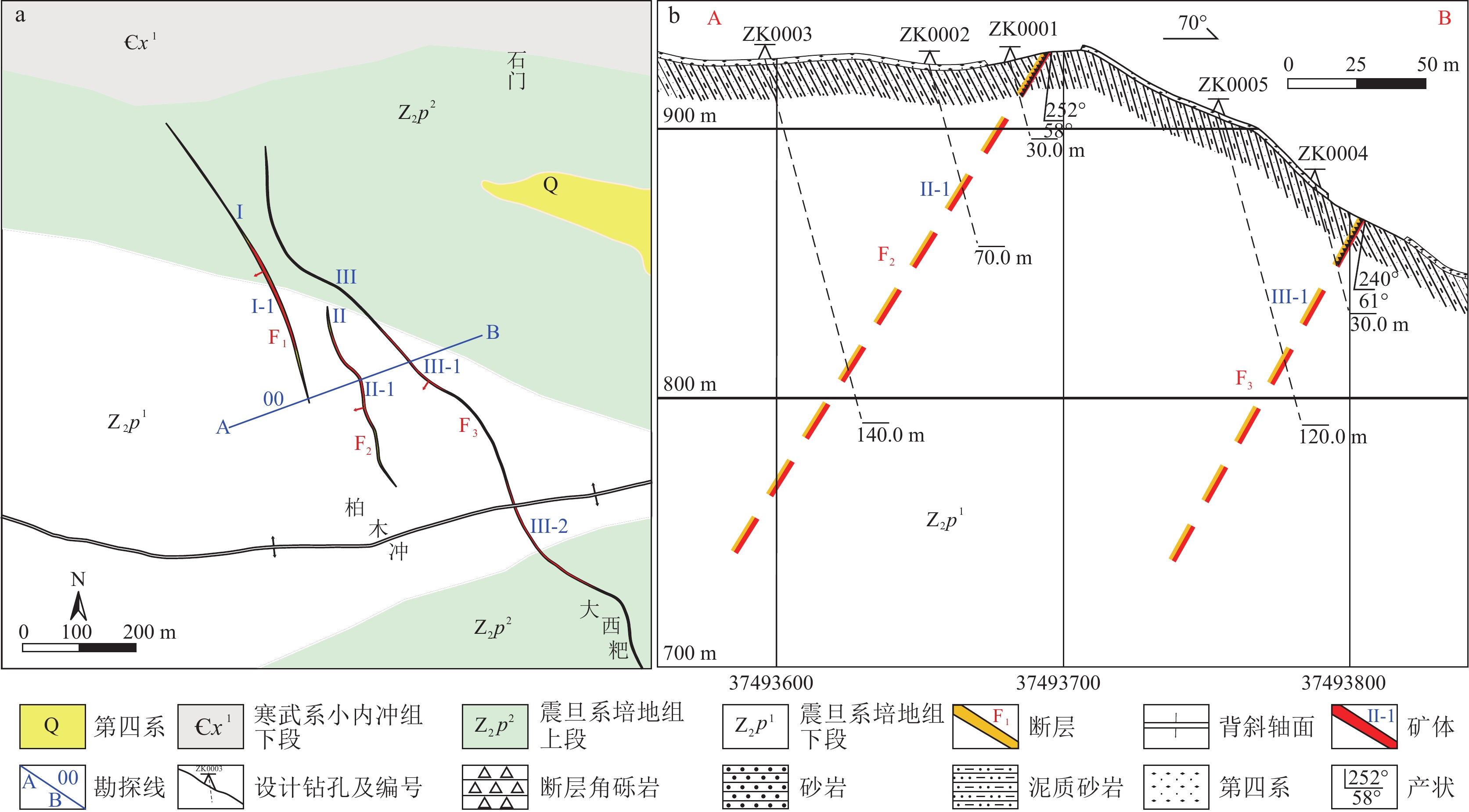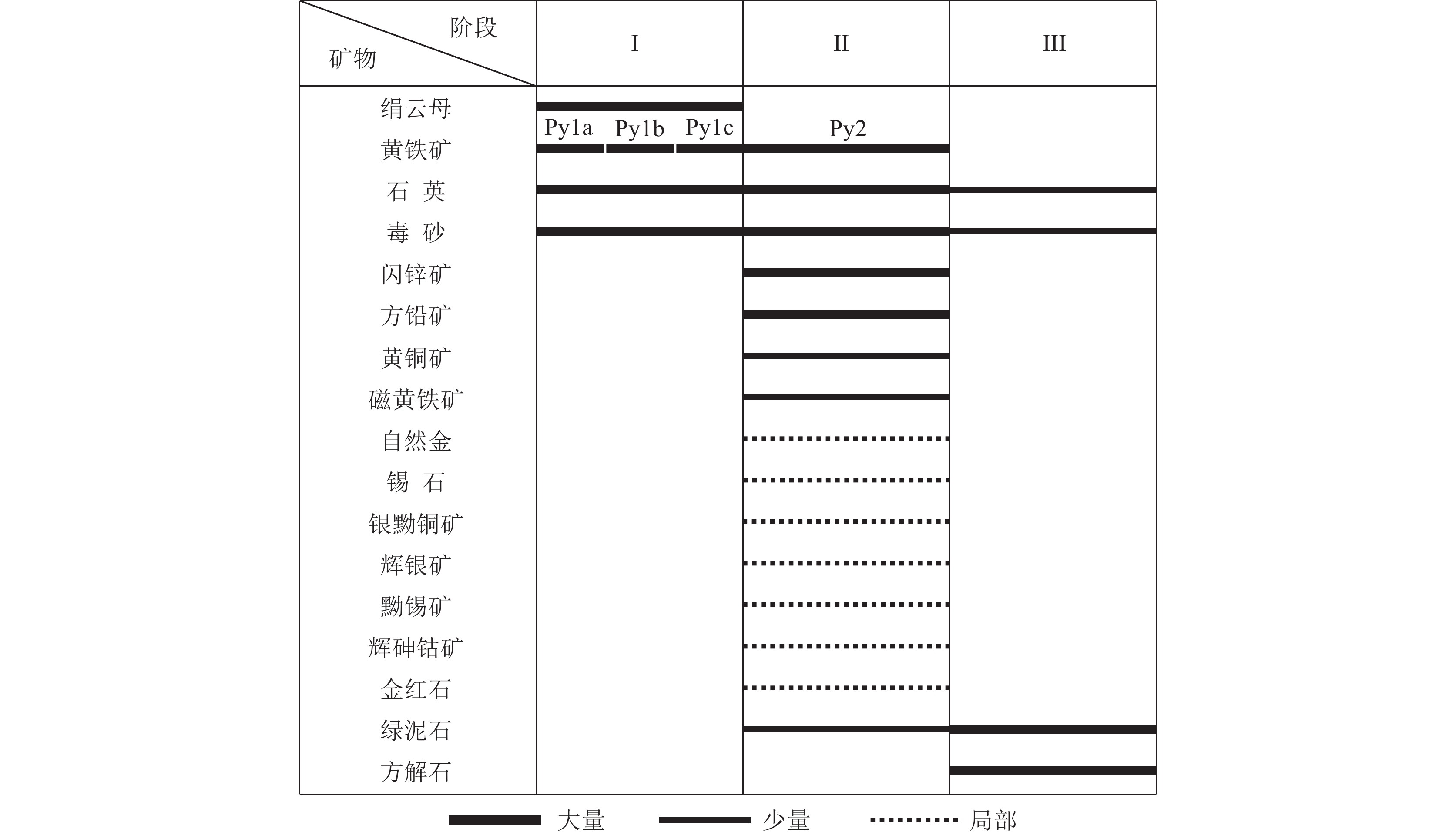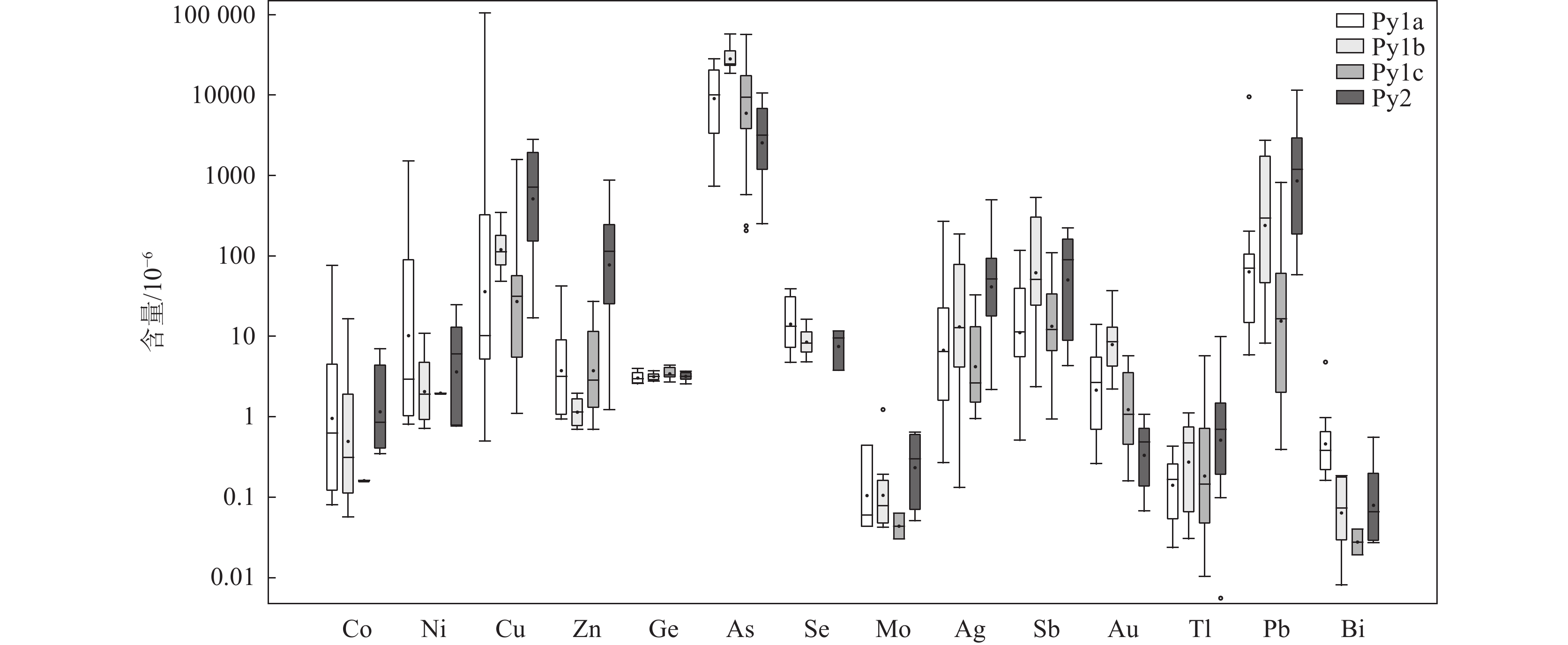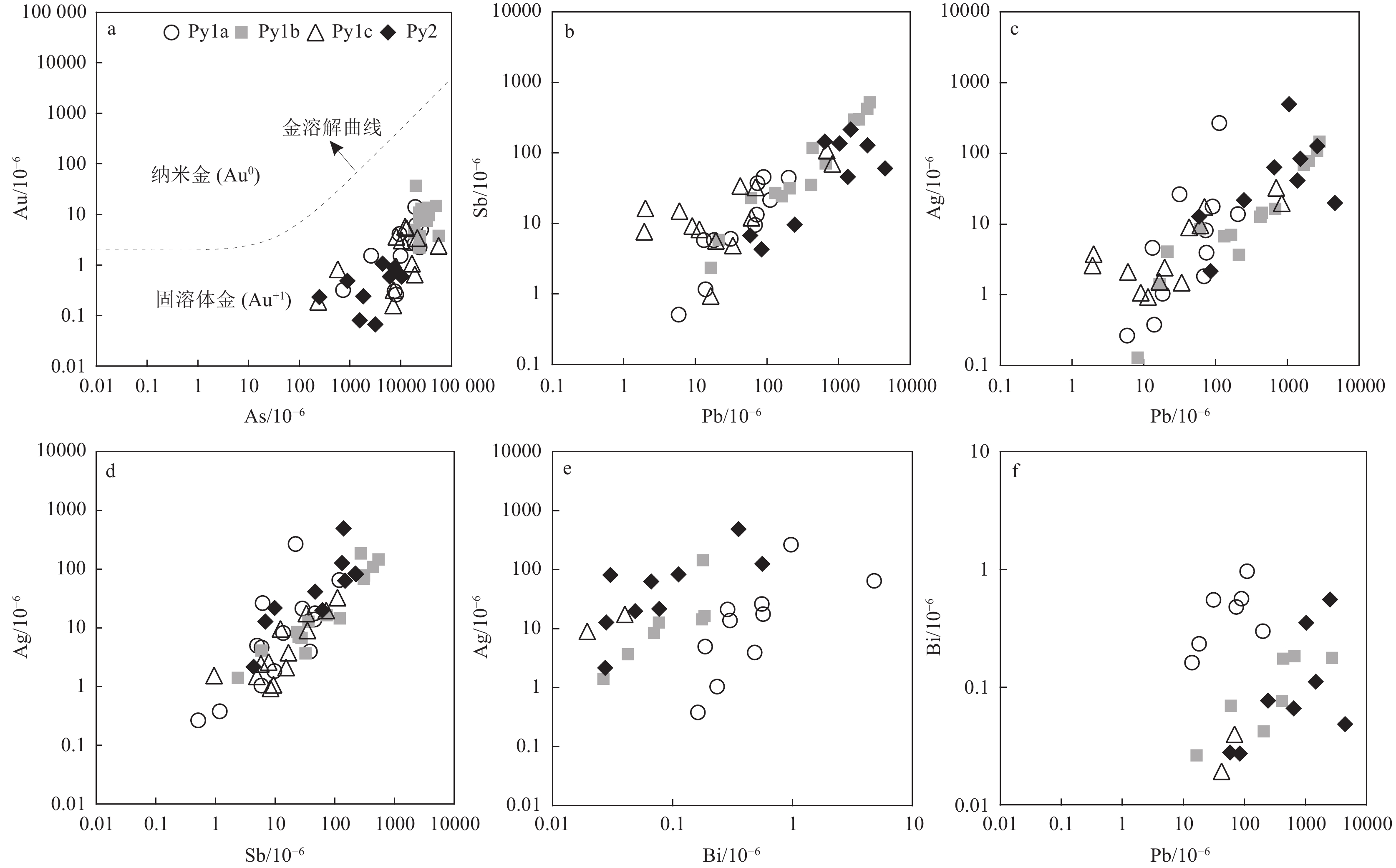Trace element geochemistry of pyrite from the Jinzhuzhou gold deposit in the Dayaoshan district, Qin-Hang Metallogenic Belt (South China): Implications for the metallogenesis
-
摘要:
研究目的 作为钦杭成矿带的重要组成部分,广西大瑶山地区发育众多金矿床,但由于成矿的精细过程、成矿物质来源等方面缺乏有效的制约,其矿床成因一直存在争议。本次以大瑶山金竹洲金矿床为研究对象,为区域金矿床成因提供约束。
研究方法 黄铁矿是热液矿床中常见的蚀变矿物,其微量元素特征能够在反演物理化学条件、制约成矿精细过程、限制矿床成因等方面发挥重要作用。通过野外地质调查,在成矿过程精细解剖的基础上,借助扫描电镜、电子探针、激光剥蚀等离子质谱仪等测试技术,开展金竹洲黄铁矿内部结构和原位微量元素研究。
研究结果 大瑶山中部的金竹洲金矿床是区内典型金矿床之一,以发育近南北向的含金石英脉为特征,其成矿过程可划分为3个阶段:(Ⅰ)石英-绢云母-黄铁矿-毒砂阶段;(Ⅱ)石英-自然金-多金属硫化物阶段;(Ⅲ)石英-方解石-绿泥石阶段。系统的背散射图像观察发现,Ⅰ阶段黄铁矿(Py1)发育明显的核-幔-边结构,Ⅱ阶段多孔状和富硫化物包裹体的黄铁矿(Py2)明显交代Ⅰ阶段黄铁矿幔部(Py1b)。原位微区微量元素分析显示,Py1核部(Py1a)Co、Ni、Se、Bi等元素含量较高;幔部(Py1b)富集As和Au;边部(Py1c)元素含量普遍偏低;Py2呈现出亏损Au、As的特征。从Py1a、Py1b到Py1c,Co、Ni两种微量元素含量呈下降趋势,反映温度逐渐降低,这可能是导致Ⅰ阶段黄铁矿出现核-幔-边结构的主要因素;孔洞状且富含包裹体(如方铅矿、辉银矿)的Py2与Py1b的交代界线呈尖锐、突变接触,同时Py2中As、Au等微量元素显著低于Py1b,说明Py2可能是Py1b经过溶解-再沉淀形成的,该作用导致Py1b中的Au发生活化并在Ⅱ阶段富集沉淀形成自然金。
结论 金竹洲黄铁矿明显富集亲岩浆元素Se(3.76×10−6 ~ 73.3×10−6,平均值16.5×10−6),结合大瑶山地区普遍发育岩浆热液成因的金矿床及深部存在巨大隐伏岩体的可能,推测金竹洲金矿床可能为岩浆热液成因。
Abstract:Objective As an important part of the Qin−Hang Metallogenic Belt, the Dayaoshan district develops abundant gold deposits. However, due to the lack of effective constraints on the ore−forming process ore source the genesis of these deposits has always been controversial. The aim of this study is to provide constraints on the deposit genesis of regional gold deposits by taking the Jinzhuzhou gold deposit in the Dayaoshan district as the study object.
Methods Pyrite is a common mineral in hydrothermal deposits, and its trace element geochemistry can play an important role in constraints on physicochemical conditions, ore−forming process and origin of deposits. In this paper, the internal structure and in situ trace element studies of Jinzhuzhou pyrite are carried out through field geological investigations, on the basis of fine dissection of the metallogenic process, and with the help of SEM, EPMA, LA−ICP−MS and other testing techniques.
Results The Jinzhuzhou gold deposit is one of the typical gold deposits in this district, and characterized by the NS−trending ore−bearing quartz veins. Its mineralization can be divided into three stages: (Ⅰ) Quartz−sericite−pyrite−arsenopyrite stage; (Ⅱ) Quartz−native gold−polymetallic sulfide stage; (Ⅲ) Quartz−calcite−chlorite stage. Systematic back−scattering imaging observations revealed that the Stage Ⅰ pyrite (Py1) has developed a distinct core−mantle−rim texture, while the porous Stage Ⅱ pyrite (Py2) trapping some sulfide inclusions commonly replaces the mantle zone (Py1b) of Py1. In−situ LA−ICP−MS trace element analysis showed that the core zone (Py1c) of Py1 is enriched in Co, Ni, Se, and Bi. Py1b is commonly enriched in As and Au, while the rim zone of (Py1c) of Py1 is commonly depleted in trace elements. Generally, Py2 is characterized by the depletion of Au−As. Notably, the Co−Ni concentrations declines from Py1a, through Py1b, to Py1c, suggesting a gradual decreasing temperature, which may have been responsible for the core−mantle−rim texture of Py1. Moreover, the sharp and irregular contact boundary between Py2 and Py1b, abundant porosities and mineral inclusion of Py2, and the lower Au−As concentrations of Py2 than Py1b, indicate that Py2 may have been formed via dissolution and precipitation of Py1b. This process results in the remobilization of gold solid solution within Py1b and the further precipitation of visible gold in Stage Ⅱ.
Conclusions Generally, the Jinzhuzhou pyrite is obviously enriched in Se (3.76 ~ 73.3×10−6, with an average of 16.5×10−6). Combining with the widespread development of magmatic−hydrothermal gold deposits, and the possible concealed magmatic pluton in the Dayaoshan district, it is inferred that the Jinzhuzhou gold deposit may have been magmatic hydrothermal origin.
-
Key words:
- pyrite /
- trace element /
- ore-forming process /
- Jinzhuzhou gold deposit /
- Dayaoshan district /
- Guangxi
-

-
图 1 大瑶山地区地质简图(据陈懋弘等,2015修改)
Figure 1.
图 2 金竹洲金矿床矿区地质图(a)和00号勘探线设计剖面图(b)(据广西昭平县金竹洲金矿勘查(变更)实施方案,2017修改)
Figure 2.
表 1 金竹洲金矿床手标本特征
Table 1. Hand specimen characteristics of the Jinzhuzhou gold deposit
序号 样品号 主要矿物组合 手标本特征 成矿阶段 1 J1-7 石英-黄铁矿 石英脉,脉中含黄铁矿细脉 Ⅰ阶段 2 J4-2 石英-黄铁矿 石英脉,脉中含少量黄铁矿 Ⅰ阶段 3 J5-3 石英-黄铁矿 石英脉,脉中含黄铁矿细脉 Ⅰ阶段 4 J6-4 石英-黄铁矿 石英脉边部蚀变晕 Ⅰ阶段 5 J1-5a 石英-黄铁矿-毒砂-方铅矿-闪锌矿 石英脉及两侧蚀变带,脉中含大量硫化物 Ⅱ阶段 6 J1-5b 石英-黄铁矿-毒砂-方铅矿-闪锌矿 石英脉及两侧蚀变带,脉中含大量硫化物 Ⅱ阶段 7 J5-1a 石英-黄铁矿-毒砂-方铅矿-闪锌矿 石英脉,脉中黄铁矿等多金属硫化物呈细脉状 Ⅱ阶段 8 J5-1b 石英-黄铁矿-毒砂-方铅矿-闪锌矿 石英脉,脉中黄铁矿等多金属硫化物呈细脉状 Ⅱ阶段 9 J7-1 石英-黄铁矿-毒砂-方铅矿-闪锌矿 石英硫化物脉,脉中含大量硫化物 Ⅱ阶段 10 J7-2 石英-黄铁矿-毒砂-方铅矿-闪锌矿 石英脉,脉中含少量硫化物 Ⅱ阶段 表 2 金竹洲金矿床黄铁矿电子探针分析结果
Table 2. Electron microprobe analyses of pyrite from the Jinzhuzhou gold deposit
% 样品 黄铁矿类型 S Fe As Co Ni Cu Pb Sb Ag Au 总量 J1-7 Py1a 53.77 46.14 0.23 - - - - - - 0.02 100.17 J1-7 Py1a 53.69 46.20 0.25 - - - - - - 0.04 100.18 J1-7 Py1a 53.84 46.37 0.02 - 0.07 - 0.02 - - - 100.32 J5-1b Py1a 53.84 46.23 0.96 - - - - - - - 101.04 J5-1b Py1a 53.62 46.40 0.64 - - - - - - - 100.66 J1-7 Py1b 53.12 46.13 1.48 - - 0.01 - - - - 100.74 J1-7 Py1b 52.87 45.80 1.50 - - - 0.04 - - 0.02 100.23 J5-1b Py1b 52.10 45.84 2.27 - - 0.02 - - - - 100.22 J5-1b Py1b 53.11 46.09 1.45 - - 0.01 - - - - 100.67 J5-1b Py1b 53.49 46.26 1.31 - - - 0.03 - - - 101.06 J1-7 Py1c 54.23 46.33 - - - - - - - 0.03 100.60 J1-7 Py1c 53.49 46.23 - - 0.01 - - - - - 99.74 J1-7 Py1c 54.06 46.24 - - - - - - - 0.05 100.36 J1-7 Py1c 52.80 46.00 - - - 0.02 - - 0.01 0.02 98.86 J1-7 Py1c 53.76 46.05 - - - - - - - 0.05 99.86 J5-1b Py2 54.49 46.50 - - - - - - - - 101.00 J5-1b Py2 54.33 46.44 - - - 0.03 0.02 - - - 100.83 J5-1b Py2 54.20 46.58 - - - 0.01 0.09 - - 0.02 100.89 J5-1b Py2 53.99 46.52 - - - - - - - - 100.51 J5-1b Py2 54.11 46.52 0.05 - 0.01 - 0.03 - - - 100.73 注:“-”表示低于检出限 表 3 金竹洲金矿床黄铁矿微量元素含量
Table 3. Electron microprobe analyses of pyrite from the Jinzhuzhou gold deposit
10−6 类型 点号 Co Ni Cu Zn Ge As Se Mo Ag Sb Te Au Tl Pb Bi Py1a J1-7-PY1 - 3.24 0.500 - 3.98 3356 - - - - - - - 0.061 - Py1a J1-7-PY5 0.624 0.913 6.46 0.934 3.29 9587 - - 1.05 5.84 - 4.11 0.367 18.1 0.234 Py1a J1-7-PY9 0.104 210 5865 739 3.54 8233 - - 26.5 6.11 - 0.261 0.053 31.2 0.554 Py1a J1-7-PY11 0.250 38.9 1.99 7.67 2.69 10068 6.82 - 0.383 1.17 - 1.52 0.024 13.9 0.162 Py1a J1-7-PY14 0.122 1.33 450 9.06 2.61 19613 9.04 - 13.9 45.1 - 14.0 0.430 201 0.300 Py1a J1-7-PY19 2.66 1513 105292 8354 2.62 2639 - - 269 21.7 - 1.53 0.171 111 0.970 Py1a J4-2PY21 11.5 47.6 326 42.4 3.19 23884 - - 17.8 46.1 - 2.24 0.234 89.9 0.567 Py1a J4-2PY22 4.51 - 11.1 6.17 2.91 2828 33.9 - 3.98 37.7 - - 0.203 73.9 0.482 Py1a J5-1aPY25 2.29 2.44 26.2 9.60 2.62 19190 11.7 0.060 1.85 9.61 - 2.65 0.160 68.2 - Py1a J7-1PY31 0.157 0.804 10.0 1.47 3.00 15304 4.74 - 21.4 28.3 - 2.70 0.238 20987 0.287 Py1a J7-1PY37 0.080 0.944 84.5 3.18 3.54 28278 38.9 - 65.5 117 - 12.1 0.324 52573 4.79 Py1a J1-5bPY48 - - 10.2 - 1.23 20381 15.3 0.043 0.269 0.512 - 6.18 0.052 5.85 - Py1a J1-5bPY49 76.0 110 9.69 2.61 3.80 25608 23.8 0.444 5.02 4.94 - 4.96 0.159 9545 0.186 Py1a J1-5bPY54 - 2.66 2.93 1.07 2.58 735 - - 4.67 5.86 - 0.321 0.054 13.1 - Py1a J1-5bPY57 - - 5.23 0.950 2.60 7676 - - 8.23 13.4 - 0.303 0.136 72.2 - Py1b J1-7-PY4 - - 60.8 - 3.49 32623 - - 1.42 2.36 - 7.53 0.044 16.4 0.026 Py1b J1-7-PY12 0.143 0.715 88.6 1.50 2.95 18949 - - 14.5 119 - 4.26 1.11 435 0.175 Py1b J1-7-PY16 0.776 10.8 347 14.2 2.89 20160 16.2 - 8.55 23.2 - 36.8 0.599 60.2 0.070 类型 点号 Co Ni Cu Zn Ge As Se Mo Ag Sb Te Au Tl Pb Bi Py1b J7-1PY27 0.313 - 101 0.770 3.75 23947 - - 78.3 305 - 8.50 0.525 1947 - Py1b J7-1PY29 - - 131 0.699 2.88 23449 - 0.097 109 429 - 9.06 0.799 2539 - Py1b J7-1PY33 1.33 1.19 81.8 1.14 3.37 57128 4.82 - 69.2 301 - 3.78 0.732 1665 - Py1b J7-1PY38 0.167 2.08 63.7 - 3.14 18728 73.3 - 186 268 1.41 4.96 0.671 587923 51.6 Py1b J5-1bPY41 2.72 20.6 48.6 1.57 2.79 24325 6.96 0.192 7.08 24.5 - 3.69 0.200 161 0.008 Py1b J5-1bPY42 0.057 1.90 345 1.76 3.32 23656 6.95 0.071 16.5 72.0 - 10.8 0.430 665 0.184 Py1b J5-1bPY45 - - 82.3 1.96 3.18 35368 9.71 0.042 3.71 31.8 - 13.5 0.075 208 0.042 Py1b J5-1bPY46 0.089 - 139 39.1 3.30 26071 10.0 1.23 12.8 35.6 - 12.9 0.309 414 0.077 Py1b J1-5bPY52 - - 13.9 - 3.37 23581 - 0.086 0.132 0.435 - 2.21 - 8.20 - Py1b J1-5bPY56 - - 124 0.791 2.76 33410 - 0.057 6.79 27.4 - 7.69 0.030 130 - Py1b J1-5bPY58 - - 245 0.825 3.15 50595 - 0.045 4.12 5.88 0.058 14.7 0.041 21.1 - Py1b J7-1@50 16.5 423 162 11.3 - 35921 - - 146 532 - 9.74 0.863 2743 0.178 Py1c J1-7-PY2 - - 71.5 - 3.51 8218 - - 1.08 9.30 - 0.937 0.042 9.05 - Py1c J1-7-PY3 - - 24.1 0.696 4.35 - - - 2.13 15.1 - - 0.766 6.00 - Py1c J1-7-PY7 - - 28.0 - 4.31 206 - - 2.63 7.72 - - 0.068 1.93 - Py1c J1-7-PY8 - - 1583 5.63 4.34 10649 - 0.063 17.6 32.9 - 3.06 1.46 69.3 0.040 Py1c J1-7-PY10 - - 56.8 - 3.16 16912 - 0.044 0.945 8.31 - 1.06 0.124 11.4 - Py1c J1-7-PY15 - - 46.7 - 3.26 237 - - 3.80 16.5 - 0.188 0.585 2.00 - Py1c J1-7-PY18 - - 710 27.2 3.11 579 - - 9.08 34.4 - 0.824 5.70 42.4 0.019 Py1c J7-1PY26 - - 36.3 17.0 1.32 13206 - 0.030 32.8 109 - 5.35 0.228 686 - 类型 点号 Co Ni Cu Zn Ge As Se Mo Ag Sb Te Au Tl Pb Bi Py1c J7-1PY34 0.161 - 3.47 2.84 2.72 8316 - - 1.55 0.942 - 3.62 0.010 16.4 - Py1c J7-1PY36 - - 8.27 1.08 3.26 21571 - - 1.50 4.91 - 3.43 - 33.4 - Py1c J7-1PY39 - 1.97 31.3 2.10 2.82 12356 - - 19.8 70.9 - 5.69 0.173 821 0.086 Py1c J1-5bPY51 - - 1.10 1.60 3.37 7206 - - - - - 0.159 - 0.701 - Py1c J1-5bPY55 1.94 - 34.9 7.66 3.34 56854 - - 9.68 12.1 - 2.39 0.079 60.8 - Py1c J1-5a@14 - - 3.13 - - 7312 - - 2.45 5.72 - 0.320 0.034 19.4 - Py1c J1-5a@15 - - 5.49 - - 19224 - - - - - 0.650 - 0.390 - Py2 J1-7-PY6 0.690 0.799 2612 81.4 3.69 4443 - 0.051 63.9 146 - 1.06 9.86 646 0.066 Py2 J1-7-PY13 - - 2797 875 3.63 1849 - - 84.3 218 - 0.242 1.63 1487 0.112 Py2 J5-1aPY23 1.06 24.6 655 126 2.92 894 - 0.501 127 130 - 0.487 1.32 2550 0.558 Py2 J5-1aPY24 - - 657 103 2.93 10590 11.6 - 82.3 223 - 0.592 0.693 11498 0.030 Py2 J7-1PY40 - 0.768 16.9 1.23 3.06 3191 - - 20.0 61.2 - 0.067 0.375 4496 0.049 Py2 J5-1bPY43 7.02 6.81 1740 9.01 3.29 6204 9.57 0.179 21.9 9.70 - 0.592 0.099 245 0.077 Py2 J5-1bPY44 - - 783 818 3.44 250 3.76 0.643 41.5 46.3 - 0.233 0.636 1354 - Py2 J1-5bPY47 0.345 6.01 167 162 3.51 7572 - - 495 138 - 0.879 1.25 1038 0.354 Py2 J1-5bPY50 - - 113 154 2.97 1568 - - 2.18 4.33 - 0.081 - 84.4 0.027 Py2 J1-5bPY53 - - 914 36.1 2.56 8.77 - - 12.8 6.80 - - 0.006 58.4 0.028 元素平均检出限 0.098 0.806 0.827 1.43 0.696 1.56 5.97 0.125 0.049 0.238 0.510 0.051 0.008 0.071 0.016 注:“-”表示低于检出限 -
[1] Barker S L L, Hickey K A, Cline J S, et al. 2009. Uncloaking invisible gold: Use of nanoSIMS to evaluate gold, trace elements, and sulfur isotopes in pyrite from Carlin−type gold deposits[J]. Economic Geology and the Bulletin of the Society of Economic Geologists, 104(7): 897−904. doi: 10.2113/econgeo.104.7.897
[2] Belousov I, Large R R, Meffre S, et al. 2016. Pyrite compositions from VHMS and orogenic Au deposits in the Yilgarn Craton, Western Australia: Implications for gold and copper exploration[J]. Ore Geology Reviews, 79: 474−499. doi: 10.1016/j.oregeorev.2016.04.020
[3] Blanchard M, Alfredsson M, Brodholt J P, et al. 2007. Arsenic incorporation into FeS 2 pyrite and its influence on dissolution: A DFT study[J]. Geochimica et Cosmochimica Acta, 71(3): 624−630. doi: 10.1016/j.gca.2006.09.021
[4] Bralia A, Sabatini G, Troja F. 1979. A revaluation of the Co/Ni ratio in pyrite as geochemical tool in ore genesis problems[J]. Mineralium Deposita, 14(3): 353−374.
[5] Butler B I, Rickard D. 2000. Framboidal pyrite formation via the oxidation of iron (II) monosulfide by hydrogen sulphide[J]. Geochimica et Cosmochimica Acta, 64(15): 2665−2672. doi: 10.1016/S0016-7037(00)00387-2
[6] Cai M H, Liu G Q. 2000. Petrogenesis and gold mineralization of silicalite from cambrian peidi formation in east Guangxi[J]. South China Geology, (1): 29−33 (in Chinese with English abstract).
[7] Cao G S, Zhang Y, Chen H Y. 2023. Trace elements in pyrite from orogenic gold deposits: Implications for metallogenic mechanism[J]. Acta Petrologica Sinica, 39(8): 2330−2346(in Chinese with English abstract). doi: 10.18654/1000-0569/2023.08.06
[8] Chen G Y, Sun D S, Yin H A. 2004. The genetic mineralogy and prospecting mineralogy[M]. Chongqing: Chongqing Publishing & Media Co. , Ltd. (in Chinese).
[9] Chen M H, Li Z Y, Li Q, et al. 2015. A preliminary study of multi−stage granitoids and related metallogenic series in Dayaoshan area of Guangxi, China[J]. Earth Science Frontiers, 22(2): 41−53 (in Chinese with English abstract).
[10] Chen M H, Dang Y, Zhang Z Q, et al. 2019. Multi−stage magmatism and mineralization in Dayaoshan area of Guangxi[M]. Beijing: Geology Press(in Chinese).
[11] Clark C, Grguric B, Mumm A S. 2004. Genetic implications of pyrite chemistry from the Palaeoproterozoic Olary Domain and overlying Neoproterozoic Adelaidean sequences, northeastern South Australia[J]. Ore Geology Reviews, 25(3/4): 237−257.
[12] Cook J N, Ciobanu L C, Meria D, et al. 2013. Arsenopyrite−pyrite association in an orogenic gold ore: Tracing mineralization history from textures and trace elements[J]. Economic Geology and the Bulletin of the Society of Economic Geologists, 108(6): 1273−1283. doi: 10.2113/econgeo.108.6.1273
[13] Dang Y, Chen M H, Mao J W, et al. 2020. Weakly fractionated I−type granitoids and their relationship to tungsten mineralization: A case study from the early Paleozoic Shangmushui deposit, Dayaoshan area, South China[J]. Ore Geology Reviews, 117: 103281. doi: 10.1016/j.oregeorev.2019.103281
[14] Deditius A P, Utsunomiya S, Renock D, et al. 2008. A proposed new type of arsenian pyrite: Composition, nanostructure and geological significance[J]. Geochimica et Cosmochimica Acta, 72(12): 2919−2933. doi: 10.1016/j.gca.2008.03.014
[15] Deditius A P, Utsunomiya S, Reich M, et al. 2011. Trace metal nanoparticles in pyrite[J]. Ore Geology Reviews, 42(1): 32−46. doi: 10.1016/j.oregeorev.2011.03.003
[16] Deditius A P, Reich M, Kesler S E, et al. 2014. The coupled geochemistry of Au and As in pyrite from hydrothermal ore deposits[J]. Geochimica et Cosmochimica Acta, 140: 644−670. doi: 10.1016/j.gca.2014.05.045
[17] Duan R C, Ling W L, Li Q, et al. 2011. Correlations of the Late Yanshanian Tectonomagmatic Events with metallogenesis in South China: Geochemical constraints from the Longtoushan gold ore deposit of the Dayaoshan area, Guangxi Province[J]. Acta Geologica Sinica, 85(10): 1644−1658(in Chinese with English abstract).
[18] Feng Y Z, Zhang Y, Xie Y L, et al. 2020. Pyrite geochemistry metallogenic implications of Gutaishan Au deposit in Jiangnan Orogen, South China[J]. Ore Geology Reviews, 117: 103298. doi: 10.1016/j.oregeorev.2019.103298
[19] Fougerouse D, Micklethwaite S, Tomkins G A, et al. 2016. Gold remobilisation and formation of high grade ore shoots driven by dissolution−reprecipitation replacement and Ni substitution into auriferous arsenopyrite[J]. Geochimica et Cosmochimica Acta, 178: 143−159. doi: 10.1016/j.gca.2016.01.040
[20] Fougerouse D, Micklethwaite S, Ulrich S, et al. 2017. Evidence for two stages of mineralization in West Africa’s largest gold deposit: Obuasi, Ghana[J]. Economic Geology, 112(1): 3−22. doi: 10.2113/econgeo.112.1.3
[21] Geisler T, Schaltegger U, Tomaschek F. 2007. Re−equilibration of zircon in Aqueous fluids and melts[J]. Elements, 3(1): 43−50. doi: 10.2113/gselements.3.1.43
[22] Gregory D D, Large R R, Halpin J A, et al. 2015. Trace element content of sedimentary pyrite in black shales[J]. Economic Geology, 110(6): 1389−1410. doi: 10.2113/econgeo.110.6.1389
[23] Hastie C E, Kontak J D, Lafrance B. 2020. Gold remobilization: Insights from gold deposits in the Archean Swayze greenstone belt, Abitibi Subprovince, Canada[J]. Economic Geology, 115(2): 241−277. doi: 10.5382/econgeo.4709
[24] Hedenquist J W, Lowenstern J B. 1994. The role of magmas in the formation of hydrothermal ore deposits[J]. Nature, 370: 519−527.
[25] Hu H, Lentz D, Li J W, et al. 2015. Reequilibration processes in magnetite from iron skarn deposits[J]. Economic Geology, 110(1): 1−8. doi: 10.2113/econgeo.110.1.1
[26] Hu Q F, Li Y, Hua E. 2011. Research on the ore−forming condition and mineralization laws on the gold deposit in Dayaoshan region, eastern Guangxi[J]. Mining Technology, 11(1): 81−83(in Chinese with English abstract).
[27] Huston D L, Sie S H, Suter G F, et al. 1995. Trace elements in sulfide minerals from eastern Australian volcanic−hosted massive sulfide deposits; Part Ⅰ, Proton microprobe analyses of pyrite, chalcopyrite, and sphalerite, and Part Ⅱ, Selenium levels in pyrite; comparison with delta 34 S values and implications for the source of sulfur in volcanogenic hydrothermal systems[J]. Economic Geology, 90(5): 1167−1196. doi: 10.2113/gsecongeo.90.5.1167
[28] Keith M, Smith D J, Jenkin G R T, et al. 2018. A review of Te and Se systematics in hydrothermal pyrite from precious metal deposits: Insights into ore−forming processes[J]. Ore Geology Reviews, 96: 269−282. doi: 10.1016/j.oregeorev.2017.07.023
[29] Keith M, Smith D J, Doyle K, et al. 2020. Pyrite chemistry: A new window into Au−Te ore−forming processes in alkaline epithermal districts, Cripple Creek, Colorado[J]. Geochimica et Cosmochimica Acta, 274: 172−191. doi: 10.1016/j.gca.2020.01.056
[30] Keith M, Haase K M, Chivas A R, et al. 2022. Phase separation and fluid mixing revealed by trace element signatures in pyrite from porphyry systems[J]. Geochimica et Cosmochimica Acta, 329: 185−205. doi: 10.1016/j.gca.2022.05.015
[31] Klose L, Keith M, Hafermaas D, et al. 2021. Trace element and isotope systematics in vent fluids and sulphides from Maka Volcano, North Eastern Lau Spreading Centre: Insights into three−component fluid mixing[J]. Frontiers in Earth Science, 9: 776925. doi: 10.3389/feart.2021.776925
[32] Koglin N, Frimmel H E, Minter L W E, et al. 2010. Trace−element characteristics of different pyrite types in Mesoarchaean to Palaeoproterozoic placer deposits[J]. Mineralium Deposita, 45(3): 259−280. doi: 10.1007/s00126-009-0272-0
[33] Kouzmanov K, Pokrovski G S. 2012. Hydrothermal controls on metal distribution in porphyry Cu (−Mo−Au) systems[M]. Society of Economic Geologists, Special Publication, 16: 573−618.
[34] Lai X, Pang B C, Li Y Q, et al. 2017. Genesis of the Wandao gold deposit in Guangxi, China: Evidences from fluid inclusions and H−O−S−Pb isotopes[J]. Geoscience, 31(5): 1006−1021(in Chinese with English abstract).
[35] Large R R, Danyushevsky L, Hollit C, et al. 2009. Gold and trace element zonation in pyrite using a laser imaging technique: Implications for the timing of gold in orogenic and Carlin−style sediment−hosted deposits[J]. Economic Geology and the Bulletin of the Society of Economic Geologists, 104(5): 635−668. doi: 10.2113/gsecongeo.104.5.635
[36] Large R R, Halpin J A, Danyushevsky L, et al. 2014. Trace element content of sedimentary pyrite as a new proxy for deep−time ocean−atmosphere evolution[J]. Earth and Planetary Science Letters, 389: 209−220. doi: 10.1016/j.jpgl.2013.12.020
[37] Li X Z, Wang Y J, Li Y X, et al. 2022. Micro−geochemical characteristic of pyrites in the Heilongou gold deposit of Penglai area and its implications for ore−forming fluid, Jiaodong gold province[J]. Geological Bulletin of China, 41(6): 1023−1038 (in Chinese with English abstract).
[38] Li Z Y, Dang Y, Le X W. 2018. Caledonian quartz vein type gold mineralization in the Dayaoshan area, Guangxi: Constraint from the muscovite 39Ar/40Ar dating in the Shangmushui gold deposit[J]. Geological Journal of China Universities, 24(5): 637−644(in Chinese with English abstract).
[39] Liu G Q, Cai M H. 2004. Ore−forming condition and genetic analysis on the gold deposit in Dayaoshan region, eastern Guangxi[J]. Bulletin of Geological Science and Technology, 23(2): 37−44(in Chinese with English abstract).
[40] Liu T F. 1997. Geological features and genesis of Au ore deposits in east Guangxi[J]. Contributions to Geology and Mineral Resources, 12(3): 11−23(in Chinese with English abstract).
[41] Lu H Z. 1990. Inclusions geochemistry[M]. Beijing: Geology Press(in Chinese).
[42] Ma Y, Jiang S Y, Frimmel H E, et al. 2022. In situ chemical and isotopic analyses and element mapping of multiple−generation pyrite: Evidence of episodic gold mobilization and deposition for the Qiucun epithermal gold deposit in Southeast China[J]. American Mineralogist, 107(6): 1133−1148.
[43] Maslennikov V V, Maslennikova S P, Large R R, et al. 2009. Study of trace element zonation in vent chimneys from the Silurian Yaman−Kasy volcanic−hosted massive sulfide deposit (Southern Urals, Russia) using laser ablation−inductively coupled plasma mass spectrometry (LA−ICPMS)[J]. Economic geology and the bulletin of the Society of Economic Geologists, 104(8): 1111−1141. doi: 10.2113/gsecongeo.104.8.1111
[44] Migdisov A, Zezin D, Williams−Jones A E. 2011. An experimental study of cobalt (Ⅱ) complexation in Cl− and H2S− bearing hydrothermal solutions[J]. Geochimica et Cosmochimica Acta, 75(14): 4065−4079. doi: 10.1016/j.gca.2011.05.003
[45] Pokrovski G S, Borisova A Y, Bychkov A Y. 2013. Speciation and Transport of Metals and Metalloids in Geological Vapors[J]. Reviews in Mineralogy and Geochemistry, 76(1): 165−218. doi: 10.2138/rmg.2013.76.6
[46] Pokrovski G S, Kokh Maria A, Proux O, et al. 2019. The nature and partitioning of invisible gold in the pyrite−fluid system[J]. Ore Geology Reviews, 109: 545−563. doi: 10.1016/j.oregeorev.2019.04.024
[47] Putnis A. 2009. Mineral replacement reactions[J]. Reviews in Mineralogy and Geochemistry, 70(1): 87−124. doi: 10.2138/rmg.2009.70.3
[48] Qian G, Xia F, Brugger J, et al. 2011. Replacement of pyrrhotite by pyrite and marcasite under hydrothermal conditions up to 220℃: An experimental study of reaction textures and mechanisms[J]. American Mineralogist, 96(11/12): 1878−1893.
[49] Qian L H, Lai J Q, Hu L F, et al. 2019. Geochronology and Geochemistry of the Granites from the Longtoushan Hydrothermal Gold Deposit in the Dayaoshan Area, Guangxi: Implication for Petrogenesis and Mineralization[J]. Journal of Earth Science, 30(2): 309−322. doi: 10.1007/s12583-018-1204-7
[50] Qin Y, Zhang Q W, Kang Z Q, et al. 2015. Geochronological framework of granitoids in Dayaoshan metallogenic belt, eastern Guangxi Province[J]. Journal of Jilin University(Earth Science Edition), 45(6): 1735−1756(in Chinese with English abstract).
[51] Reich M, Kesler S E, Utsunomiya S, et al. 2005. Solubility of gold in arsenian pyrite[J]. Geochimica et Cosmochimica Acta, 69(11): 2781−2796. doi: 10.1016/j.gca.2005.01.011
[52] Reich M, Deditius A, Chryssoulis S, et al. 2013. Pyrite as a record of hydrothermal fluid evolution in a porphyry copper system: A SIMS/EMPA trace element study[J]. Geochimica et Cosmochimica Acta, 104: 42−62. doi: 10.1016/j.gca.2012.11.006
[53] Roedder E. 1972. Barite fluid inclusion geothermometry, Cartersville Mining District, Northwest Georgia; discussion[J]. Economic Geology, 67(6): 821−822. doi: 10.2113/gsecongeo.67.6.821
[54] Román N, Reich M, Leisen M, et al. 2019. Geochemical and micro−textural fingerprints of boiling in pyrite[J]. Geochimica et Cosmochimica Acta, 246: 60−85. doi: 10.1016/j.gca.2018.11.034
[55] Rottier B, Kouzmanov K, Wälle M, et al. 2016. Sulfide replacement processes revealed by textural and LA−ICP−MS trace element analyses: Example from the early mineralization stages at Cerro de Pasco, Peru[J]. Economic Geology, 111(6): 1347−1367. doi: 10.2113/econgeo.111.6.1347
[56] Savage K S, Tingle T N, Peggy A O, et al. 2000. Arsenic speciation in pyrite and secondary weathering phases, Mother Lode Gold District, Tuolumne County, California[J]. Applied Geochemistry, 15(8): 1219−1244. doi: 10.1016/S0883-2927(99)00115-8
[57] Sheng Z H. 2005. Gold metallogenic pattern in Dayaoshan ore belt[J]. Contributions to Geology and Mineral Resources Research, B08: 61−63(in Chinese with English abstract).
[58] Simon G, Kesler E S, Chryssoulis S. 1999. Geochemistry and textures of gold−bearing arsenian pyrite, Twin Creeks, Nevada: Implications for deposition of gold in Carlin−type deposits[J]. Economic Geology, 94(3): 405−421. doi: 10.2113/gsecongeo.94.3.405
[59] Sun P F, Wang Q F, Li H J, et al. 2020. Geology and pyrite sulfur isotopes of the Suoluogou gold deposit: Implication for crustal continuum model of orogenic gold deposit in northwestern margin of Yangtze Craton, SW China[J]. Ore Geology Reviews, 122: 103487. doi: 10.1016/j.oregeorev.2020.103487
[60] Sung Y H, Brugger J, Ciobanu C L, et al. 2009. Invisible gold in arsenian pyrite and arsenopyrite from a multistage Archaean gold deposit: Sunrise Dam, Eastern Goldfields Province, Western Australia[J]. Mineralium Deposita, 44(7): 765−791. doi: 10.1007/s00126-009-0244-4
[61] Tan H J, Shao Y J, Liu Q Q, et al. 2022. Textures, trace element geochemistry and in−situ sulfur isotopes of pyrite from the Xiaojiashan gold deposit, Jiangnan Orogen: Implications for ore genesis[J]. Ore Geology Reviews, 144: 104843. doi: 10.1016/j.oregeorev.2022.104843
[62] Thomas H V, Large R R, Bull S W, et al. 2011. Pyrite and pyrrhotite textures and composition in sediments, laminated quartz veins, and reefs at Bendigo Gold Mine, Australia: Insights for ore genesis[J]. Economic geology and the bulletin of the Society of Economic Geologists, 106(1): 1−31. doi: 10.2113/econgeo.106.1.1
[63] Velásquez G, Béziat D, Salvi S, et al. 2014. Formation and deformation of pyrite and implications for gold mineralization in the El Callao District, Venezuela[J]. Economic Geology, 109(2): 457−486. doi: 10.2113/econgeo.109.2.457
[64] Wang G M, Huang C X, Wei Z R, et al. 2017. Spatial and temporal distribution of metal deposits in Dali area, Guangxi, South China[J]. Geology and Mineral Resources of South China, 33(1): 47−64(in Chinese with English abstract).
[65] Wang J C, Hu Y H, Ye L. 2010. Metallotectonical types and indication of the gold deposits in Dayaoshan area in the east of Guangxi[J]. Journal of Guilin University of Technology, 30(4): 467−473(in Chinese with English abstract).
[66] Wang X Y, Liu M C, Zhou G F, et al. 2013. A correlation study of au−polymetallic mineralization and granite−porphyry magmatism in the Xinping mining area of the Dayaoshan metallogenic belt, eastern Guangxi Province[J]. Geoscience, 27(3): 585−592(in Chinese with English abstract).
[67] Wu Y F, Evans K, Li J W, et al. 2019. Metal remobilization and ore−fluid perturbation during episodic replacement of auriferous pyrite from an epizonal orogenic gold deposit[J]. Geochimica et Cosmochimica Acta, 245: 98−117. doi: 10.1016/j.gca.2018.10.031
[68] Xiao L Y, Chen M H, Zhang Z Q, et al. 2015. The deposit type, mineralization age and their geological significance of the Wandao gold deposit in Zhaoping County, Guangxi Province[J]. Earth Science Frontiers, 22(2): 118−130 (in Chinese with English abstract).
[69] Zeng C Y. 1996. The relation of the feature of the deep structure to gold mineralization in the upwarping region of Dayao mountain in eastern Guangxi[J]. Journal of Guilin University of Technology, 16(3): 245−251 (in Chinese with English abstract).
[70] Zhang Y, Shao Y J, Chen H Y, et al. 2017. A hydrothermal origin for the large Xinqiao Cu−S−Fe deposit, Eastern China: Evidence from sulfide geochemistry and sulfur isotopes[J]. Ore Geology Reviews, 88: 534−549.
[71] Zhang Y, Tian J, Hollings P, et al. 2020a. Mesozoic porphyry Cu−Au mineralization and associated adakite−like magmatism in the Philippines: Insights from the giant Atlas deposit[J]. Mineralium Deposita, 55(5): 881−900. doi: 10.1007/s00126-019-00907-2
[72] Zhang Y, Hollings P, Shao Y J, et al. 2020b. Magnetite texture and trace−element geochemistry fingerprint of pulsed mineralization in the Xinqiao Cu−Fe−Au deposit, Eastern China[J]. American Mineralogist, 105(11): 1712−1723. doi: 10.2138/am-2020-7414
[73] Zhang Y, Chen H Y , Cheng J M, et al. 2022. Pyrite geochemistry and its implications on Au−Cu skarn metallogeny: An example from the Jiguanzui deposit, Eastern China[J]. American Mineralogist, 107(10): 1910−1925.
[74] Zhang Z W, Li H, Yu B, et al. 2014. The Mineralization Age of the Gupao Gold Deposit, Guangxi[J]. Applied Mechanics and Materials, 2974(501/504): 327−330.
[75] Zhu G T. 2002. Study on geological character and genesis of Longtoushan gold deposit of Guangxi[J]. Mineral Resources and Geology, 16(5): 266−272 (in Chinese with English abstract).
[76] 蔡明海, 刘国庆. 2000. 桂东寒武系培地组硅质岩成因与金的富集[J]. 华南地质与矿产, (1): 29−33.
[77] 曹根深, 张宇, 陈华勇. 2023. 造山型金矿床黄铁矿微量元素对成矿机制的指示[J]. 岩石学报, 39(8): 2330−2346. doi: 10.18654/1000-0569/2023.08.06
[78] 陈光远, 孙岱生, 殷辉安. 2004. 成因矿物学与找矿矿物学[M]. 重庆: 重庆出版社.
[79] 陈懋弘, 李忠阳, 李青, 等. 2015. 初论广西大瑶山地区多期次花岗质岩浆活动与成矿系列[J]. 地学前缘, 22(2): 41−53.
[80] 陈懋弘, 党院, 张志强, 等. 2019. 广西大瑶山地区多期次岩浆活动及成矿作用[M]. 北京: 地质出版社.
[81] 段瑞春, 凌文黎, 李青等. 2011. 华南燕山晚期构造-岩浆事件与成矿作用: 来自广西大瑶山龙头山金矿床的地球化学约束[J]. 地质学报, 85(10): 1644−1658.
[82] 广西壮族自治区第一地质队. 2017. 广西昭平县金竹洲金矿勘查(变更)实施方案[R].
[83] 胡乔帆, 李毅, 华二. 2011. 大瑶山地区金矿成矿条件及成矿规律研究[J]. 采矿技术, 11(1): 81−83. doi: 10.3969/j.issn.1671-2900.2011.01.031
[84] 赖昕, 庞保成, 李院强, 等. 2017. 广西昭平湾岛金矿的成因: 流体包裹体和H−O−S−Pb同位素地球化学约束[J]. 现代地质, 31(5): 1006−1021. doi: 10.3969/j.issn.1000-8527.2017.05.011
[85] 李秀章, 王勇军, 李衣鑫, 等. 2022. 胶东蓬莱黑岚沟金矿床黄铁矿微区地球化学特征及对成矿流体的启示[J]. 地质通报, 41(6): 1023−1038.
[86] 李忠阳, 党院, 乐兴文. 2018. 广西大瑶山地区加里东期石英脉型金矿: 上木水金矿白云母Ar−Ar年龄约束[J]. 高校地质学报, 24(5): 637−644.
[87] 刘国庆, 蔡明海. 2004. 桂东大瑶山地区金矿成矿条件及成因分析[J]. 地质科技情报, 23(2): 37−44.
[88] 刘腾飞. 1997. 桂东金矿成矿地质特征及矿床成因[J]. 地质找矿论丛, 12(3): 11−23.
[89] 卢焕章. 1990. 包裹体地球化学[M]. 北京: 地质出版社.
[90] 秦亚, 张青伟, 康志强, 等. 2015. 桂东大瑶山成矿带花岗岩类岩石年代学格架的厘定[J]. 吉林大学学报(地球科学版), 45(6): 1735−1756.
[91] 盛志华. 2005. 大瑶山成矿带金矿成矿规律[J]. 地质找矿论丛, B08: 61−63. doi: 10.3969/j.issn.1001-1412.2005.01.012
[92] 汪劲草, 胡云沪, 叶琳. 2010. 桂东大瑶山地区金矿床的成矿构造类型及其成矿指示[J]. 桂林理工大学学报, 30(4): 467−473. doi: 10.3969/j.issn.1674-9057.2010.04.001
[93] 王功民, 黄赤新, 韦子任, 等. 2017. 广西大黎地区金属矿床时空分布规律[J]. 华南地质与矿产, 33(1): 47−64.
[94] 王新宇, 刘名朝, 周国发, 等. 2013. 桂东大瑶山成矿带新坪矿区花岗斑岩与金多金属成矿作用关系[J]. 现代地质, 27(3): 585−592. doi: 10.3969/j.issn.1000-8527.2013.03.009
[95] 肖柳阳, 陈懋弘, 张志强, 等. 2015. 广西昭平湾岛金矿矿床类型、成矿时代及其地质意义[J]. 地学前缘, 22(2): 118−130.
[96] 曾崇义. 1996. 桂东大瑶山隆起区深部构造特征与金矿成矿作用的关系[J]. 桂林工学院学报, 16(3): 245−251.
[97] 朱桂田. 2002. 广西龙头山金矿床地质特征及成因研究[J]. 矿产与地质, 16(5): 266−272. doi: 10.3969/j.issn.1001-5663.2002.05.003
-



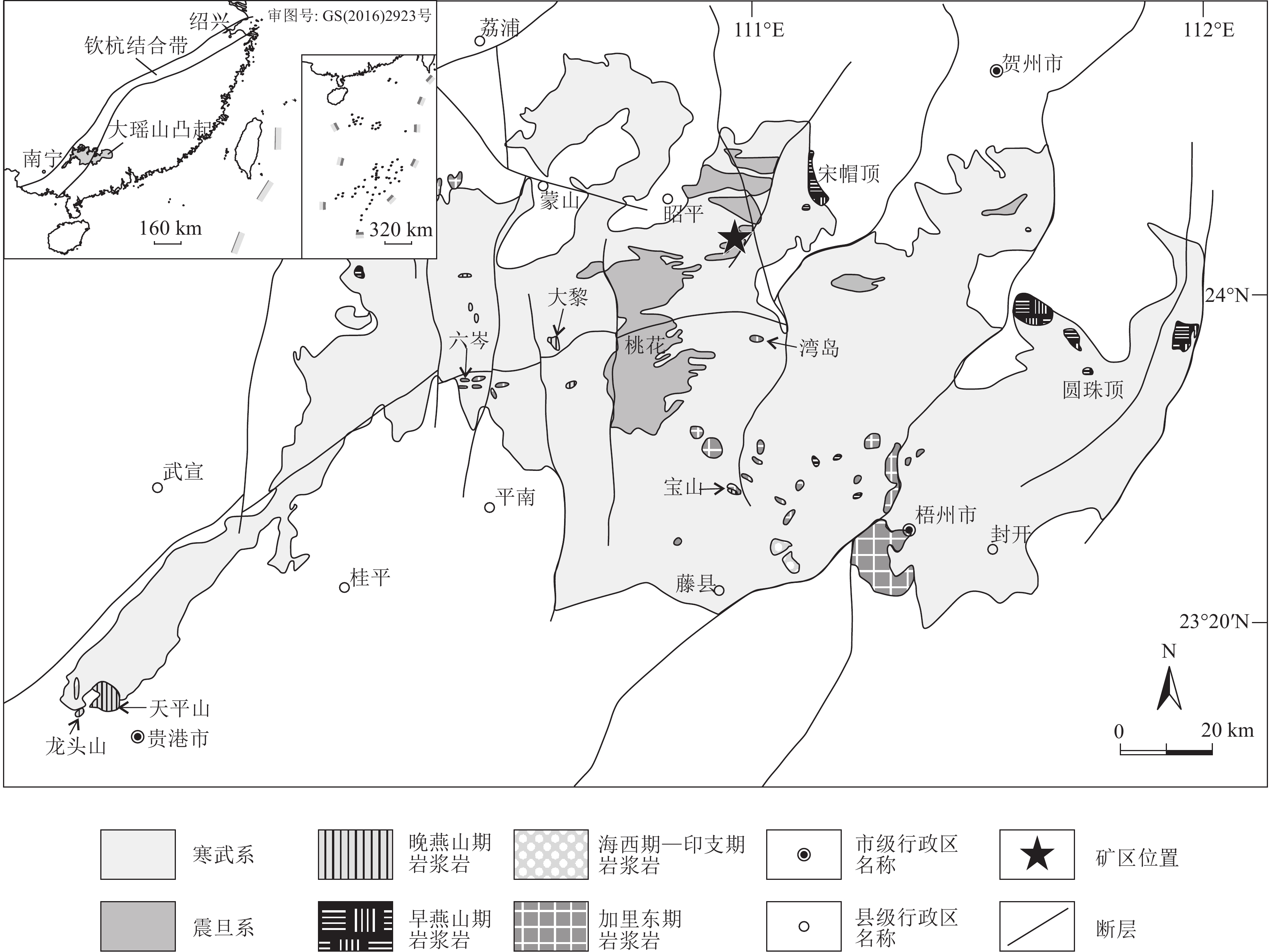
 下载:
下载:
